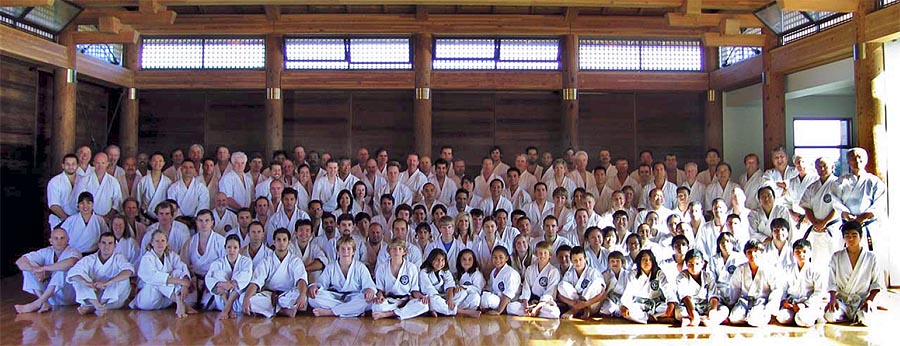Tsutomu Ohshima (SKA founder) explains gyaku-zuki (and martial arts) during our year-end practice at Shotokan Ohshima Dojo in Santa Barbara, California December 1, 2007.

group photo from Dec 1,2007 year end practice (Ohshima Sensei standing at far right)
Liberal transcript from video above:
00:03
Caltech captain, come here. (laughter)…
Randy McClure is teaching you there..
OK. Many people think this (arm only) is punching, so (they think) this (indicates shoulder, arm, and fist) is the important part, but that’s only one small part of it. If you think of the whole being, mind and feeling and breathing and body and movement top to bottom which you have (a better idea of it)… But if you only think of this and this and this (shoulder and arm parts) when you punch, well, OK, a big guy can make it work against a small guy. But your opponents are bigger than you, half of them anyway – you have to use your whole strength. Every time you think of this, no matter what kind of technique (you have to use your whole strength).
01:14
But we’re missing something, Because in 1952, some guy invented the tournament system (referring to himself), so they (tournament competitors and officials) will go “YAHHH! Oh! It’s ippon, ippon!” But I’m not so sure – if you attack POM (demonstrating lousy tournament tap). It doesn’t work. Because to most people it LOOKS good, is it OK? No. We are not practicing that way. If it’s really working, then we accept it. OK?
01:45
So, when you touch here (Caltech captain’s solar plexus), not only this part (the punching shoulder and arm), but also here (hips and knees and forehead and pulling shoulder) – everything goes here (to solar plexus). But movement is important, too. If you go straight, your focus goes straight. If you’re swinging, swinging is (reminds Caltech captain to tighten his abdomen), if you just swing your arm, it doesn’t work. So, when you swing, use your whole body (demonstrates), OK? So when you swing this way, the whole body can swing. But when you’re thrusting here (solar plexus again), and you turn your pulling shoulder away, power goes backwards. I’ll show you how (that occurs). Because somebody, somebody… Somebody was practicing this way before, in some other school (looking around, he’s unable to quickly locate such a person in the large (about 150 members) group)?
02:48
OK. Look at this. From here – UMMMMH! (pulling shoulder goes back) – only a little power goes in. But if this goes together here (indicates pulling shoulder going in, too), and then… Black Belts: many of you are stuck here and just go BOOM – then it doesn’t work! The moment when you go in, THIS is important – this movement (hips and body) is important! The (pulling shoulder) doesn’t move this way (backward). So just a little (penetrates). Does that look the same? But it’s different, do you understand? So make it clear. Every goes in. Timing! Many black belts (are punching first then their hips move after, or their hips move first, then their punch comes after). It isn’t effective that way, do you understand? Especially the pulling shoulder – don’t pull it away. It should go IN. And the hips, too, must go IN. Do you get it? So from here, it goes – WHAMMM! The front knee has to go IN. The front hip can’t rotate backwards away from the punch. Get it?
03:58
How can you learn it? In the beginning (this is directed to junior members), it looks easy, but it’s really a little bit difficult. I suggest you pay attention to your fist alignment (so the wrist can’t bend up or down when you punch). Everything goes together. When you practice this with your black belt instructor, ask him to tighten his stomach (laughter), from here, go this way – POM (penetrates). Is that different? Yes! Now he understands! (referring to Caltech captain who’s been getting punched around a bit — laughter).
04:40
OK. This is for senior black belts. When your punch connects with your hip movements and your breathing (here in tanden), then your gyaku-zuki is most accomplished. The important thing is ultimately your breathing and your mentality alone. Ideal breathing comes with your ideal mentality. That’s why we consider martial arts something important to finish inside. OK? Think of it. That’s all I can say. It’s too complicated to communicate, really. (Caltech captain is dismissed).
05:50
So black belts must practice gyaku-zuki all together with hips. Mind leads breathing. Breathing leads body. So it’s one. Which one is first? The mind. Mind? I’m talking about emotionally, which means ‘under’ the conscious mind. That’s the main part of the mind. That’s what goes first. What do I mean by breathing? It’s that ‘steam’ which comes out from that feeling which is our unconscious mind. And this ‘steam’ all comes with your breathing. Then your body automatically follows. So the ideal level of practice which black belts are looking for is that this whole mind, mainly the subconscious mind, with this ‘steam’ called ‘ki’ or ‘chi’, and the body become one. This is your strongest energy coming out. OK? That’s all connected with your basics. Basics by itself, your physical movement, your mechanical movement by itself does not exist. How you feel is what connects your mind and body. That is good.
7:38
OK, just fix small things, small things, and maybe that will work.
